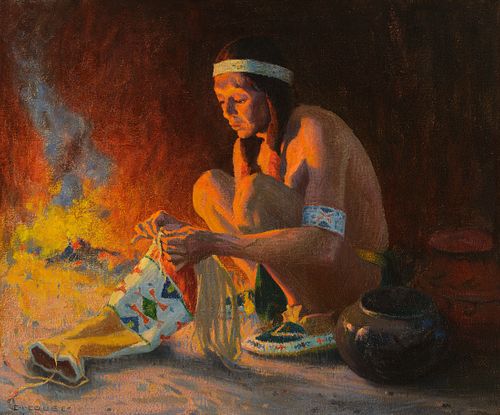Eanger Irving Couse (1866-1936); The Tobacco Bag (circa 1920)
Lot 139
About Seller
Coeur d'Alene Art Auction
11944 North Tracey Road
Hayden, ID 83835
United States
Coeur d’Alene Art Auction specializes in the finest classical Western and American Art representing past masters and outstanding contemporary artists. The auction principals have over 100 years of combined experience in selling fine art and have netted their clients over $325 million in the last fif...Read more
Categories
Estimate:
$100,000 - $150,000
Absentee vs Live bid
Two ways to bid:
- Leave a max absentee bid and the platform will bid on your behalf up to your maximum bid during the live auction.
- Bid live during the auction and your bids will be submitted real-time to the auctioneer.
Bid Increments
| Price | Bid Increment |
|---|---|
| $0 | $250 |
| $5,000 | $500 |
| $10,000 | $1,000 |
| $20,000 | $2,500 |
| $50,000 | $5,000 |
| $100,000 | $10,000 |
| $200,000 | $25,000 |
| $500,000 | $50,000 |
| $1,000,000 | $100,000 |
About Auction
By Coeur d'Alene Art Auction
Jul 25, 2020
Set Reminder
2020-07-25 15:00:00
2020-07-25 15:00:00
America/New_York
Bidsquare
Bidsquare : Fine Western & American Art
https://www.bidsquare.com/auctions/coeur-dalene/fine-western-american-art-5263
The 2020 Coeur d'Alene Art Auction to be held July 25 in Reno, Nevada, will feature 264 selections of unparalleled quality in Western paintings and sculpture from historical and contemporary artists such as Charles M. Russell, Henry Farny, Thomas Moran, Edward S. Curtis, Carl Rungius, and more. Coeur d'Alene Art Auction info@cdaartauction.com
The 2020 Coeur d'Alene Art Auction to be held July 25 in Reno, Nevada, will feature 264 selections of unparalleled quality in Western paintings and sculpture from historical and contemporary artists such as Charles M. Russell, Henry Farny, Thomas Moran, Edward S. Curtis, Carl Rungius, and more. Coeur d'Alene Art Auction info@cdaartauction.com
- Lot Description
Eanger Irving Couse (1866-1936)
The Tobacco Bag (circa 1920)
oil on canvas
20 x 24 inches
signed lower left
VERSO
Label, Nedra Matteucci Galleries, Santa Fe, NM
Historian Virginia Couse Leavitt writes, “Couse was a great admirer of the Indian as an artist. In The Tobacco Bag he shows his Native American model working on the fringed end of a large beaded bag. Beadwork is also featured in this painting in the headband, armband, and moccasins worn by the model. Couse’s model was Ben Lujan, from Taos Pueblo, although the artifacts come from other cultures. The painting is about artistry not about ethnography.
“Over the years, Couse made a large collection of beadwork, pottery, and other Native American artifacts that he used extensively as props in his paintings. Most of his collection still exists in his studio at The Couse Foundation in Taos, although the bag pictured in this painting is unfortunately no longer in the collection.
“The bag was large enough to accommodate a full, disassembled pipe, and would therefore more accurately be called a ‘pipe bag.’ Tobacco bags are normally small pouches meant only to hold tobacco, although the two terms are often used interchangeably. Chelsea Herr, PhD Candidate in Native American Art at the University of Oklahoma, has helped identify this bag as Northern Plains, most likely Lakota or Dakota. She interprets the beadwork as a medicine lodge design, which makes sense because of the connection between tobacco and medicine.
“Fire is a symbol of cleansing and renewal, and smoke, which can be created in a pipe, carries prayers to the Great Spirit. It is appropriate therefore that Couse made his painting a firelight scene.”Surface condition is excellent. Painting has been lined. Spots of inpainting throughout.Condition
- Buyer's Premium



 EUR
EUR CAD
CAD AUD
AUD GBP
GBP MXN
MXN HKD
HKD CNY
CNY MYR
MYR SEK
SEK SGD
SGD CHF
CHF THB
THB












